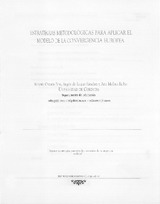Estrategias metodológicas para aplicar el modelo de la Convergencia Europea
Autor
Ontoria Peña, Antonio
Luque Sánchez, Ángela de
Molina Rubio, Ana
Editor
Universidad de Córdoba, Vicerrectorado de Innovación y Calidad DocenteFecha
2004Materia
European creditMobility
European convergence
Methological strategies
Learning-centered in the student
Competences
Teacching model
Cooperative learning
Employment and competitiveness
Learning to learn
Competencias
Aprendizaje cooperativo
Convergencia europea
Empleo y competitividad
Modelo docente
Estrategias metodológicas
Aprendizaje centrado en el alumno
Crédito europeo
Movilidad
Aprender a aprender
METS:
Mostrar el registro METSPREMIS:
Mostrar el registro PREMISMetadatos
Mostrar el registro completo del ítemResumen
Our purpose is to reflect about the meaning of the teaching new model in the European Convergence: "Learning-centered in the Student" (ACA). We make reference to the EEES creation and to the longlife learning in the knowledge Europe. After comparing both significances of the ACC, we observe that its option is "learning-centered in the work". The European Credit, a cornerstone of the ACA, shows to the student as an "executor agent of the "workload" designed by the teacher o Department, but he's nota "constructivist agent". A "learning by competences" is emphasized to the Higher studies "harmonization" and "flexibility" in UE for the enhance of the "mobility, employment" and "Competitiveness". Nevertheless, the adopted teaching model promotes changes in the methodology and knowledge contents with the integration of the individual and groupal work. Nuestro objetivo es reflexionar sobre la interpretación que la convergencia europea hace del nuevo modelo docente "Aprendizaje Centrado en el Alumno" (ACA). Contextualizamos el trabajo con una alusión a la creación del EEES y al aprendizaje permanente (Longlife learning) en la Europa del conocimiento. Al comparar los dos significados del ACA, vemos que se opta por el "centrado en el trabajo", pues el crédito europeo (ECTS), concreción del ACA, revela que el alumno es un agente ejecutor, no constructor, del "volumen de trabajo" diseñado por el profesor/Dpto. Se potencia "un aprendizaje por competencias" para la armonización de los estudios superiores en la UE que facilite "movilidad", "empleo" y "competitividad". No obstante, el modelo docente adoptado facilita el cambio metodológico y de contenidos, integrando el trabajo individual y cooperativo.

